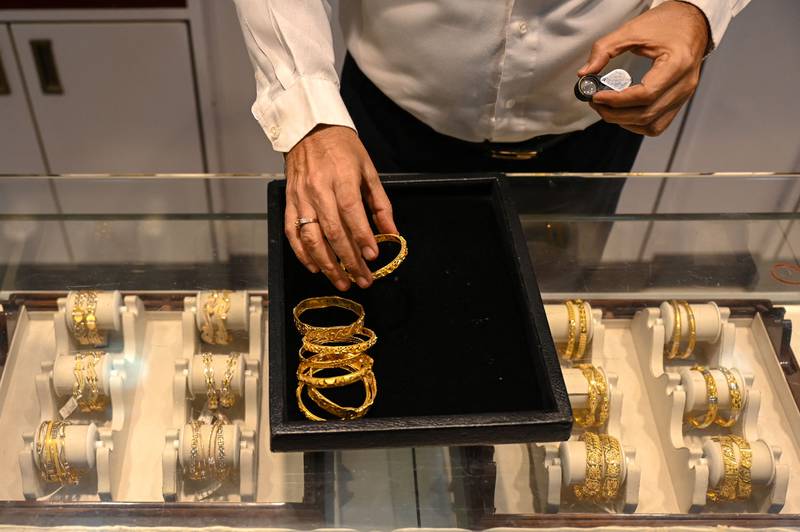Global gold demand rose 10% in 2021 on jewellery sales and central bank purchases

Global gold demand rose 10 per cent in 2021 to 4,021 tonnes, recouping much of the coronavirus-induced losses sustained in 2020.
The growth was driven by a surge in jewellery purchases and central banks, which shored up their bullion reserves, according to the World Gold Council.
However, investment demand was mixed as high inflation competed with rising yields for investor attention, the WGC said in its annual report on Friday. “On the investment side, the tug of war between persistent inflation and rising rates created a mixed picture for demand. Increasing rates fuelled a risk-on appetite among some investors, reflected in ETF outflows,” said Louise Street, senior analyst for Europe, the Middle East and Africa at the World Gold Council.
“On the other hand, a search for safe-haven assets led to a rise in gold bar and coin purchases, buoyed by central bank buying. Declines in ETFs [exchange-traded funds] were offset by demand growth in other sectors. “Jewellery reached its highest level in nearly a decade as key markets like China and India regained economic vibrancy.”
In 2020, the Covid-19 pandemic hammered jewellery sales, forcing investors to stockpile as they sought a safe place to store wealth. That trend reversed as economic growth rebounded, boosting consumer spending and weakening investor appetite.
In the fourth quarter of 2021, gold demand jumped 50 per cent a year to 1,147 tonnes, its highest quarterly level since the period from April to June 2019. This was due to a rise in jewellery purchases at the end of the year, according to the WGC. Jewellery fabrication made a solid recovery in 2021, growing 67 per cent to 2,221 tonnes — the highest since 2018 — to meet the strong rebound in consumer demand for jewellery.
Jewellery sales grew 52 per cent to 2,124 tonnes in 2021, matching the total in 2019. This was partly due to fourth-quarter demand, which — at 713 tonnes — was the strongest three-month consumption since the second quarter of 2013.
“India was a key driver in the fourth quarter but jewellery demand in markets across the globe — almost without exception — was stronger year-on-year”, the WGC said. “Continued economic recovery and, crucially, the less widespread use of strict lockdown measures to contain Covid, were key reasons.”
Indian gold jewellery demand almost doubled annually in 2021, surging past pre-pandemic levels to hit a six-year high of 611 tonnes. Record quarterly demand of 265 tonnes in the fourth quarter sealed the “remarkable” annual performance, the council said.
Markets in the Middle East all registered significant double-digit annual growth in demand for jewellery in 2021. The UAE led with a 57 per cent increase in annual demand to 34 tonnes. This was due to the continued improvement in tourist numbers, especially from India and the effective containment of Covid-19 that boosted local demand, the WGC said.
Central banks accumulated 463 tonnes of gold in 2021, an 82 per cent increase from 2020, to lift global reserves to close to a 30-year high.
However, the pace of buying slowed in the second half, falling 22 per cent in the fourth quarter. A diverse group of central banks in both emerging and developed markets added to their gold reserves. Thailand, which last added to its gold reserves in 2017, was the largest buyer in 2021, the WGC said. According to data from the International Monetary Fund, central bank gold reserves around the world rose to about 35,600 tonnes in 2021, the highest level since 1992.
Gold bar and coin demand rose 31 per cent to an eight-year high of 1,180 tonnes as retail investors sought a safe haven against the backdrop of rising inflation and continued economic uncertainty caused by the pandemic, the WGC said.
The Middle East registered a third consecutive decline in annual bar and coin demand, down 4 per cent to 55 tonnes. The decline was driven solely by Iran, where high inflation and rising housing costs continued to sap demand, which fell 30 per cent to 25 tonnes.
In contrast, demand across the rest of the region was strong. The UAE jumped to eight tonnes, the highest level since 2015. In 2021, investors in gold-backed exchange-traded funds sold more bullion than they bought, weakening overall demand. Global holdings of gold ETFs fell by 173 tonnes in 2021, in sharp contrast to 2020's record 874-tonne increase.
“Interest rates, representing the opportunity cost for holding gold, are historically a key determinant of ETF flows and last year was no exception,” the council said.
Gold prices ended 2021 about 4 per cent lower. They closed the year at $1,806 an ounce, falling from record highs above $2,000 an ounce during the investment frenzy in 2020.
Looking ahead at 2022, investment in gold “may face challenges from rising rates, and the recent strong increase in bar and coin demand may be an additional headwind to further growth", the WGC said. It expects persistently high inflation and equity market pullbacks to be supportive.
Demand for jewellery in 2022 should benefit from weaker prices with good underlying economic growth. Central banks are expected to continue buying gold, although at a slower pace than in 2021, it said. “How central banks deal with persistent high levels of inflation will be a key factor for institutional and retail demand in 2022,” Ms Street said.
“Meanwhile, the jewellery market’s current strength could be hampered if new Covid variants restrict consumer access again or continue if the economic recovery endures.”
